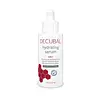What's inside
What's inside
 Key Ingredients
Key Ingredients

 Benefits
Benefits

 Concerns
Concerns

 Ingredients Side-by-side
Ingredients Side-by-side

Water
Skin ConditioningPropanediol
SolventButylene Glycol
HumectantSodium Hyaluronate
HumectantSea Water
HumectantChlorella Vulgaris Extract
Skin ConditioningHydrolyzed Algin
Glycerin
HumectantCarbomer
Emulsion StabilisingSodium Lauryl Sulfoacetate
CleansingSodium Oleate
CleansingSodium Oleoyl Sarcosinate
Tetrasodium Glutamate Diacetate
Hydroxyacetophenone
AntioxidantPentylene Glycol
Skin ConditioningSodium Chloride
MaskingSodium Hydroxide
BufferingPhenoxyethanol
PreservativeWater, Propanediol, Butylene Glycol, Sodium Hyaluronate, Sea Water, Chlorella Vulgaris Extract, Hydrolyzed Algin, Glycerin, Carbomer, Sodium Lauryl Sulfoacetate, Sodium Oleate, Sodium Oleoyl Sarcosinate, Tetrasodium Glutamate Diacetate, Hydroxyacetophenone, Pentylene Glycol, Sodium Chloride, Sodium Hydroxide, Phenoxyethanol
Water
Skin ConditioningGlycerin
HumectantNiacinamide
SmoothingPunica Granatum Fruit Water
AstringentSodium Hyaluronate
HumectantTocopherol
AntioxidantXanthan Gum
EmulsifyingPentylene Glycol
Skin ConditioningSodium Lauryl Sulfoacetate
CleansingSodium Oleoyl Sarcosinate
Ethylhexylglycerin
Skin ConditioningSodium Gluconate
Skin ConditioningSodium Chloride
MaskingSodium Oleate
CleansingCitrus Aurantium Dulcis Peel Oil
MaskingSodium Sulfate
Citric Acid
BufferingPhenoxyethanol
PreservativeSodium Benzoate
MaskingParfum
MaskingLimonene
PerfumingCI 14700
Cosmetic ColorantWater, Glycerin, Niacinamide, Punica Granatum Fruit Water, Sodium Hyaluronate, Tocopherol, Xanthan Gum, Pentylene Glycol, Sodium Lauryl Sulfoacetate, Sodium Oleoyl Sarcosinate, Ethylhexylglycerin, Sodium Gluconate, Sodium Chloride, Sodium Oleate, Citrus Aurantium Dulcis Peel Oil, Sodium Sulfate, Citric Acid, Phenoxyethanol, Sodium Benzoate, Parfum, Limonene, CI 14700
Ingredients Explained
These ingredients are found in both products.
Ingredients higher up in an ingredient list are typically present in a larger amount.
Glycerin is already naturally found in your skin. It helps moisturize and protect your skin.
A study from 2016 found glycerin to be more effective as a humectant than AHAs and hyaluronic acid.
As a humectant, it helps the skin stay hydrated by pulling moisture to your skin. The low molecular weight of glycerin allows it to pull moisture into the deeper layers of your skin.
Hydrated skin improves your skin barrier; Your skin barrier helps protect against irritants and bacteria.
Glycerin has also been found to have antimicrobial and antiviral properties. Due to these properties, glycerin is often used in wound and burn treatments.
In cosmetics, glycerin is usually derived from plants such as soybean or palm. However, it can also be sourced from animals, such as tallow or animal fat.
This ingredient is organic, colorless, odorless, and non-toxic.
Glycerin is the name for this ingredient in American English. British English uses Glycerol/Glycerine.
Learn more about GlycerinPentylene glycol is typically used within a product to thicken it. It also adds a smooth, soft, and moisturizing feel to the product. It is naturally found in plants such as sugar beets.
The hydrophilic trait of Pentylene Glycol makes it a humectant. As a humectant, Pentylene Glycol helps draw moisture from the air to your skin. This can help keep your skin hydrated.
This property also makes Pentylene Glycol a great texture enhancer. It can also help thicken or stabilize a product.
Pentylene Glycol also acts as a mild preservative and helps to keep a product microbe-free.
Some people may experience mild eye and skin irritation from Pentylene Glycol. We always recommend speaking with a professional about using this ingredient in your routine.
Pentylene Glycol has a low molecular weight and is part of the 1,2-glycol family.
Learn more about Pentylene GlycolPhenoxyethanol is a preservative that has germicide, antimicrobial, and aromatic properties. Studies show that phenoxyethanol can prevent microbial growth. By itself, it has a scent that is similar to that of a rose.
It's often used in formulations along with Caprylyl Glycol to preserve the shelf life of products.
Chances are, you eat sodium chloride every day. Sodium Chloride is also known as table salt.
This ingredient has many purposes in skincare: thickener, emulsifier, and exfoliator.
You'll most likely find this ingredient in cleansers where it is used to create a gel-like texture. As an emulsifier, it also prevents ingredients from separating.
There is much debate on whether this ingredient is comedogenic. The short answer - comedogenic ratings don't tell the whole story. Learn more about comegodenic ratings here.
The concensus about this ingredient causing acne seems to be divided. Research is needed to understand if this ingredient does cause acne.
Scrubs may use salt as the primary exfoliating ingredient.
Learn more about Sodium ChlorideSodium Hyaluronate is hyaluronic acid's salt form. It is commonly derived from the sodium salt of hyaluronic acid.
Like hyaluronic acid, it is great at holding water and acts as a humectant. This makes it a great skin hydrating ingredient.
Sodium Hyaluronate is naturally occurring in our bodies and is mostly found in eye fluid and joints.
These are some other common types of Hyaluronic Acid:
Learn more about Sodium HyaluronateSodium Lauryl Sulfoacetate is an organic salt with a naturally sweet odor. It is an alternative to traditional sulfates and is commonly found in "sulfate-free" products.
In cosmetics, this ingredient is used to increase the volume of foam, emulsify ingredients, and as a cleansing agent.
As a cleansing agent, sodium lauryl sulfoacetate helps reduce the surface tension of dirt, oil, and other pollutants so they can be rinsed away easily.
Cosmetic Ingredient Review found this ingredient to irritate the eyes and skin in concentrations of 0.18% and 0.7%.
Learn more about Sodium Lauryl SulfoacetateWe don't have a description for Sodium Oleate yet.
We don't have a description for Sodium Oleoyl Sarcosinate yet.
Water. It's the most common cosmetic ingredient of all. You'll usually see it at the top of ingredient lists, meaning that it makes up the largest part of the product.
So why is it so popular? Water most often acts as a solvent - this means that it helps dissolve other ingredients into the formulation.
You'll also recognize water as that liquid we all need to stay alive. If you see this, drink a glass of water. Stay hydrated!
Learn more about Water